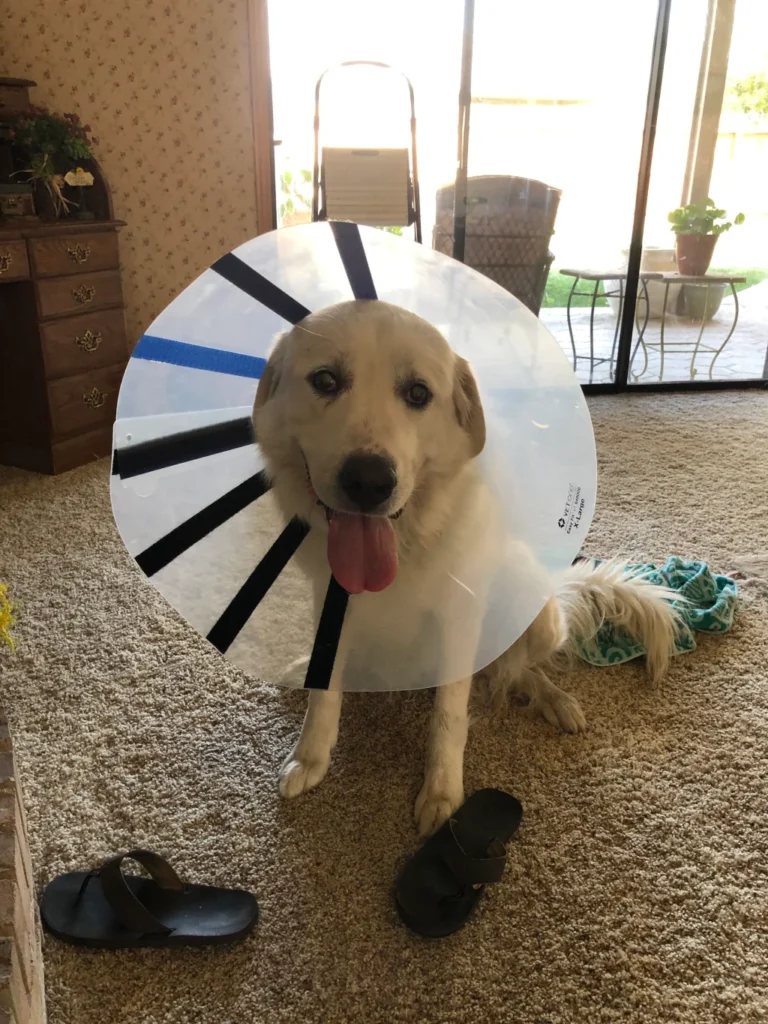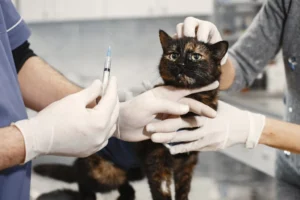Imagine this: you’re having your morning coffee, and your furry friend is curled up by your side. Everything seems perfect, right?
But then, you remember that you want the best for your dog and the topic of neutering crosses your mind. You ask yourself: should you spay or neuter your dog? Maybe your vet mentioned it at the last visit, or perhaps a friend suggested it.
You can’t shake the feeling of uncertainty. After all, isn’t it a big decision? Absolutely. But that’s why we’re here, diving deep into this topic, breaking down the benefits, the misconceptions, and answering your questions. Ready? Your cup of insight is about to be filled.

Why Spay or Neuter Your Dog?
Spaying or neutering your dog, also called “gonadectomy”, is more than just a surgical procedure. It’s a responsible step toward your dog’s overall health and wellness.
It helps control the dog population and reduces the number of homeless dogs. But there’s more. Spaying or neutering can also lessen behavioral issues such as aggression, marking territory, or escaping to find a mate.
Plus, it saves you the trouble of dealing with a dog in heat or a male attracted to a female in heat, which can be a challenging experience for any dog owner.
Does Spaying or Neutering Really Reduce Cancer Risk in Dogs?
Let’s dive into the science bit. Research has shown that spaying and neutering can indeed help reduce the risk of certain cancers in dogs.
Female dogs, when spayed before their first heat, are less likely to develop mammary gland tumors, which can be cancerous in about 50% of dogs. Spaying female dogs before their second heat cycle or before they reach 2.5 years old can greatly decrease their risk of developing mammary neoplasia.
Neutering male dogs can prevent testicular cancer and significantly lower the risk of prostate problems. While it’s not a silver bullet against all health issues, it’s a preventative measure that can contribute to a healthier, longer life for your pooch.

How Does Spaying or Neutering Affect a Dog’s Lifespan?
When it comes to a dog’s lifespan, spaying or neutering can potentially increase it.
Numerous studies suggest that spayed or neutered dogs often live longer than their intact counterparts. This longevity is largely due to a decrease in the risks of certain diseases and health complications.
For example, spaying a female dog at the time of mastectomy can help prevent new mammary tumors and uterine infections, while neutering a male eliminates the risk of testicular cancer. However, individual dog health and lifespan are also heavily influenced by factors like diet, exercise, genetics, and overall care.
In general, spayed/neutered dogs have been found to live longer than non-neutered dogs. Life expectancy increased by 26.3% in females and 13.8% in males.
Here’s a table from research published in December of 2022 showing the benefits and risks with and without spaying/neutering for dogs:
| Benefit | Risk with gonadectomy | Risk without gonadectomy |
|---|---|---|
| Longevity in dogs | Males: 13.8% increase in life span Females: 26.3% increase in lifespan | – |
| Pyometra | 0 | 25%–66% in those over 9–10 years old |
| Mammary tumors | 0.5% if prior to the first estrus | 23%–63%, with 50% being malignant |
| Benign prostatic hyperplasia | 0 | 75%-80% of unneutered dogs may develop serious prostate diseases by age 6, and nearly 100% by age 9. |
| Testicular neoplasia | 0 | Risk unknown, but <1% will die from tumor |

Does Spaying or Neutering Affect Dog Behavior?
Absolutely, spaying or neutering can affect your dog’s behavior, and in many cases, for the better.
Let’s start with males. Neutered dogs tend to exhibit less territorial and aggressive behaviors. This includes urine marking, roaming in search of a mate, and some forms of dog-dog aggression. It’s a bit like turning down the volume on these testosterone-driven behaviors.
Now, about the ladies. Spaying eliminates the heat cycle, and with it, behaviors like restlessness and howling, which can be stressful for both you and your pet. Not to mention, you can say goodbye to the flock of hopeful males camping on your doorstep.
However, it’s important to remember that spaying or neutering isn’t an instant fix for deep-rooted behavioral issues, and should not be used as a substitute for training. It’s part of a wider approach towards your dog’s well-being, which also involves good nutrition, regular exercise, and positive reinforcement training methods.
Remember that the impact of spaying or neutering on your dog’s behavior may vary based on their age, breed, individual personality, and environmental factors.
Suggested read: Dog Neutering Process from Surgery to Recovery
If you have concerns, a chat with your vet or a certified dog behaviorist can offer valuable, tailored advice for your four-legged friend.
Are There Any Downsides to Spaying or Neutering a Dog?
While the benefits of spaying or neutering your dog outweigh the negatives for most pet owners, there are a few potential downsides to consider.
Some studies suggest a correlation between neutering and an increased risk of certain types of cancers, obesity, and orthopedic issues. Additionally, spaying or neutering too early may interfere with a puppy’s growth and development.
Spayed/neutered dogs had higher instances of certain diseases, but lower instances of trauma, infectious, vascular, and degenerative diseases.
However, these risks are generally quite low, and the timing and appropriateness of the procedure can be carefully discussed with your veterinarian to ensure the best decision for your dog’s overall health and well-being. The right timing is crucial.
Suggested read: When to spay or neuter your dog
Here’s a table from the same study we used for Table 1 of potential risks for several breeds based on neuter status and timing of the procedure (refer below for abbreviation meanings):
| Breed | Sex | Risk | Gonadectomy ≤12 months | Gonadectomy >12 months | Intact |
|---|---|---|---|---|---|
| Rottweiler | M | OSA | 28% | – | 8% |
| F | 25% | – | 8% | ||
| Golden retriever | M | Hip dysplasia | 10.2% | 3.1% | 5.1% |
| Golden retriever | M | CCL rupture | 5.1% | 1.4% | 0 |
| F | 7.7% | 0 | 0 | ||
| Golden retriever | M | LSA | 9.6% | 0 | 3.5% |
| Golden retriever | F | HSA | 1.8% | 7.4% | 1.6% |
| Golden retriever | F | MCT | 2.3% | 5.7% | 0 |
| Labrador retriever | M | CCL rupture | <6 m – 7.6% | 12–23 m – 1.9% | 2.3% |
| 6–11 m – 2.8% | 2–8 y – 0 | ||||
| Labrador retriever | M | Elbow dysplasia | <6 m – 4.2% | 12–23 m – 0 | 0.6% |
| 6–11 m – 0 | 2–8 y – 2.2% | ||||
| Labrador retriever | F | Hip dysplasia | <6 m – 5.4% | 12–23 m – 4.3% | 1.7% |
| 6–11 m – 5.1% | 2–8 y – 0 | ||||
| Vizsla | M | LSA | 0.3% | 0.4% | 0.2% |
| F | 0.3% | 1.1% | 0.1% | ||
| Vizsla | M | HSA | 0 | 0.6% | 0.4% |
| F | 0.5% | 1.1% | 0.1% | ||
| Vizsla | M | MCT | 0.5% | 1.3% | 0.5% |
| F | 1.1% | 1.9% | 0.6% |
Source: Current perspectives on the optimal age to spay/castrate dogs and cats, Lisa M. Howe, Texas A&M University; Veterinary Medicine Research.
Choosing to spay or neuter your dog is a pivotal decision, affected by health, behavior, and ethical factors. The optimal choice prioritizes your pet’s health and wellbeing.
Always seek a pet health professional for advice personalized to your pet’s needs. This exploration of information is a testament to your responsible pet ownership. Keep learning, because your pet depends on you. In their world, you are their best friend.

Glossary of Terms:
- Gonadectomy: A general term for the surgical removal of the reproductive organs in both males (neutering) and females (spaying).
- Mammary Neoplasia: Tumors in mammary glands, potentially cancerous.
- Pyometra: Serious, life-threatening uterus infection in females.
- Osteosarcoma (OSA): A type of bone cancer.
- Cranial Cruciate Ligament (CCL): An important ligament in the knee joint of dogs. Ruptures can lead to severe lameness and arthritis.
- Lymphoma/Lymphosarcoma (LSA): Cancer of lymphocytes, a part of the immune system.
- Hemangiosarcoma (HSA): A fast-growing, highly invasive variety of cancer, occurring almost exclusively in dogs.
- Mast Cell Tumor (MCT): A type of tumor consisting of mast cells, which can be benign (non-cancerous) or malignant (cancerous).
Knowledge of these terms is part of effective pet health management. Good job on seeking this information!
FAQs
What are the benefits of spaying or neutering a dog?
Spaying or neutering a dog reduces the risk of certain health issues, including certain cancers and infections. It can also mitigate aggressive and territorial behaviors and prevent unwanted litters.
Do spayed or neutered dogs gain weight?
Spayed or neutered dogs may be prone to weight gain as the procedure can slow their metabolism. However, with balanced nutrition and regular exercise, weight can be effectively managed.
Can a dog be too old for spaying or neutering?
While there’s no set age limit for spaying or neutering a dog, the procedure’s risks can increase with age and underlying health conditions. Therefore, a comprehensive vet examination is crucial before deciding to proceed with the surgery in older dogs.
Alex, a passionate animal lover, has experience in training and understanding animal behavior. As a proud pet parent to two dogs and three cats, he founded AnimalReport.net to share insights from animal experts and expand his knowledge of the animal kingdom.









